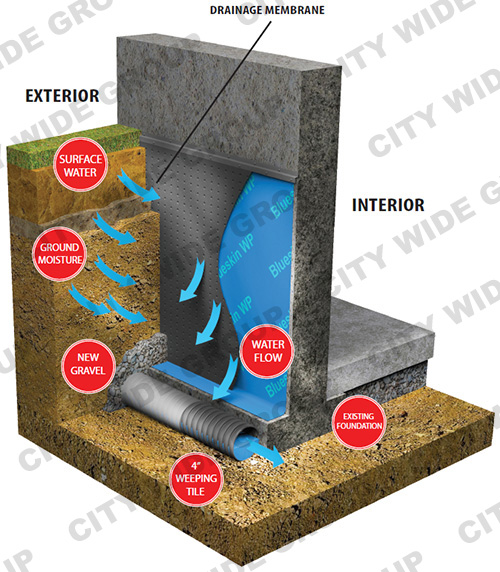 Waterproofing your foundation will stop water from entering your basement and eliminate that musty smell, allergy causing mould, or damage to your belongings. Water and moisture can weaken the footings of your home’s foundation and cause it to settle which will produce cracks in the walls. Taking the step to waterproof the exterior walls of your foundation will protect the structural integrity of your home.
Waterproofing your foundation will stop water from entering your basement and eliminate that musty smell, allergy causing mould, or damage to your belongings. Water and moisture can weaken the footings of your home’s foundation and cause it to settle which will produce cracks in the walls. Taking the step to waterproof the exterior walls of your foundation will protect the structural integrity of your home.
Exterior waterproofing is the way to go because you are preventing the water to enter at the foundation. By exposing the foundation you are able to restore it to its natural state and gain access to the area to install a new weeping bed providing greater drainage.
You can save thousands of dollars by avoiding the need for expensive and disruptive repairs or rebuilds. Real Estate agents will tell you if you want to sell your home at a good price, you need to fix any moisture problems first. Your property’s value increases when it has been expertly waterproofed.
Exterior Waterproofing Procedures:
- Excavate around the perimeter of the foundation. Depending on the elevation of your property this can range from five to eight feet deep and approximately two and half feet wide. Additional steps would be required if the foundations are deeper.
- Shoring is installed to ensure the safety of the workers and preventing any cave-in of the soil around the home.
- Old weeping tiles are removed and new continuous four-inch weeping tiles with filter cloth are installed.
- The foundation walls are thoroughly cleaned and inspected. Repairs of voids, cracks or other defects are conducted with an expandable hydraulic cement. In the case where a foundation is made of poured concrete, cement blocks, bricks, or stone/rubble the surface may be too rough for a membrane to be installed, we will parge the area with cement.
- A primer is applied as an activator for the rubber bithuane membrane which is applied in three-foot wide sheets with a minimum six-inch overlap. The rubber membrane will not dry up or crack and has enough flexibility to allow for expansion and contraction.
- A dimpled sheet of drainage membrane (Delta MS) is fastened to the top with a termination bar creating a void between the rubber membrane and soils to be backfilled.
- A layer of ¾ clear gravel is then placed over the weeping tiles to allow for better drainage.
- Any windows installed below the grade will require a window well made from pressure-treated wood or a pre-cast stainless steel with a four-inch vertical drain and filled with ¾ clear gravel to allow the water to drain directly into the weeping tile system.
- The area is backfilled with its native soil and compacted in 12 inch lifts to its original level and graded away from the property to allow water to run off.
- Once completed to your satisfaction you are given a receipt and a fully transferable Life Time Warranty certificate.

